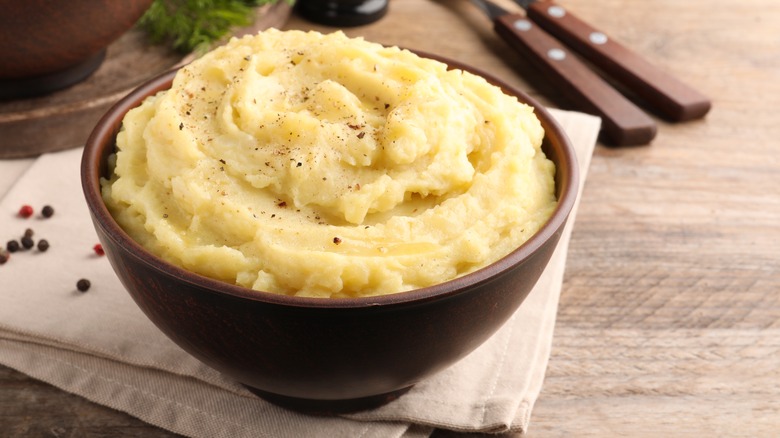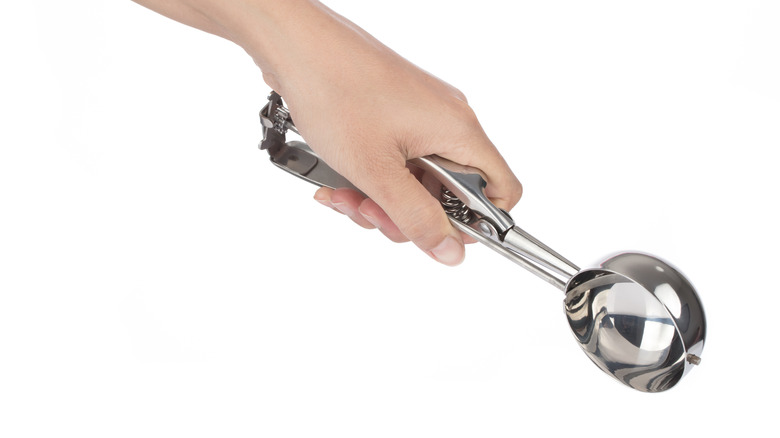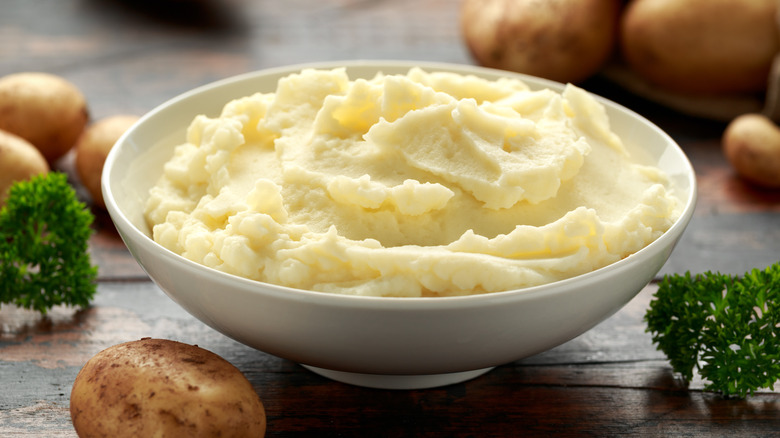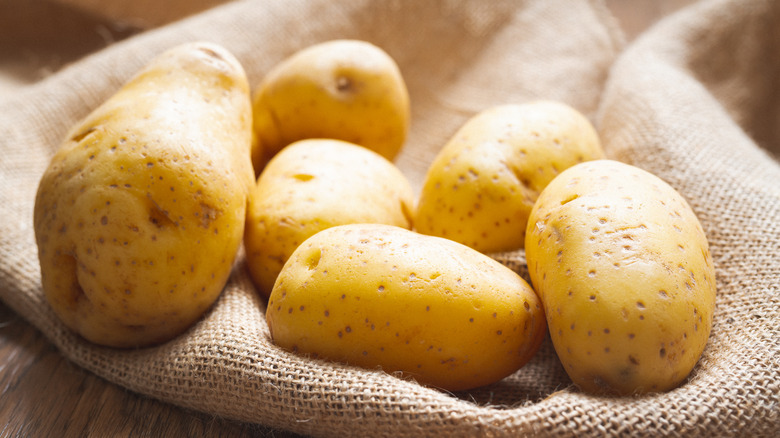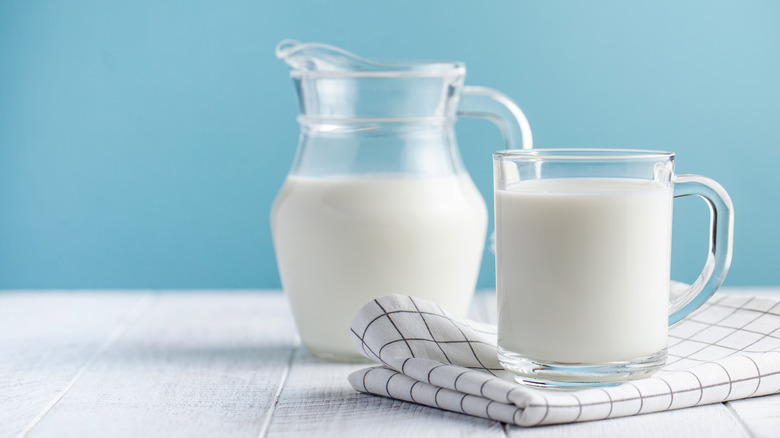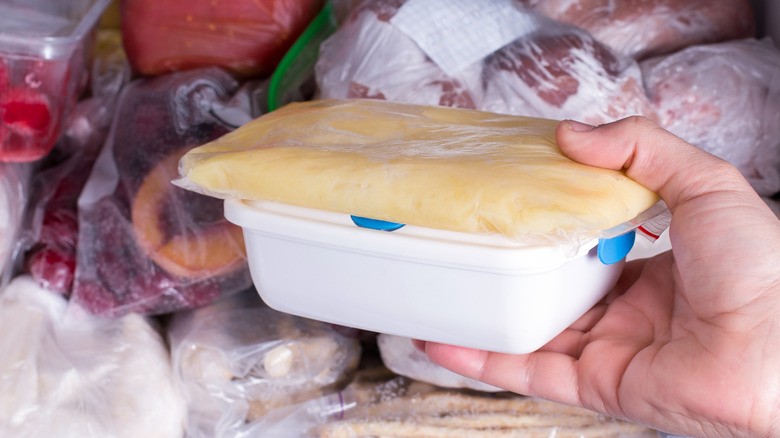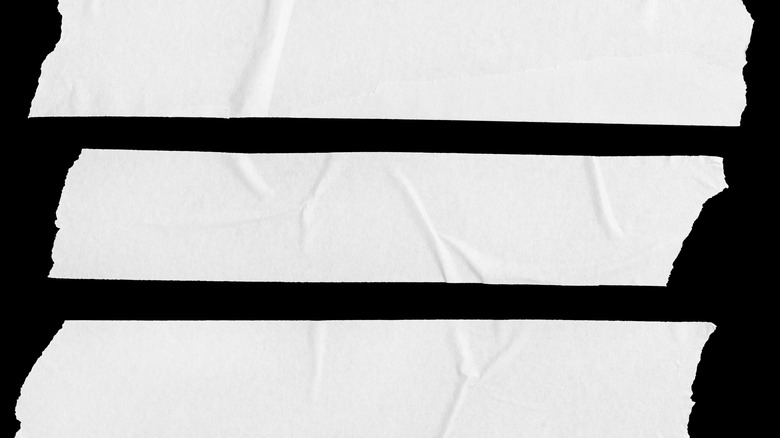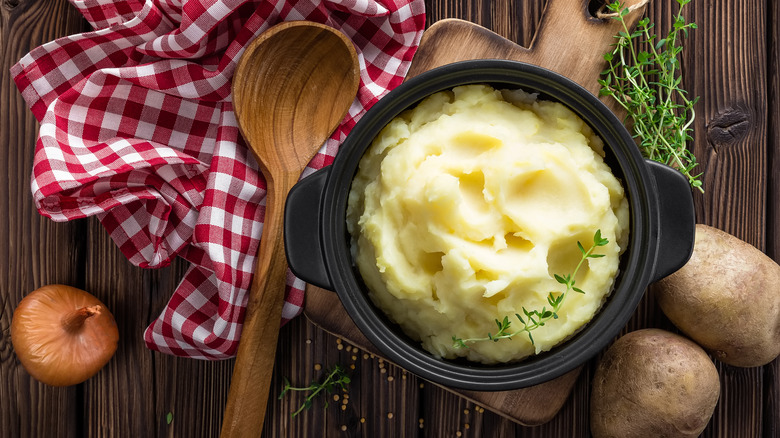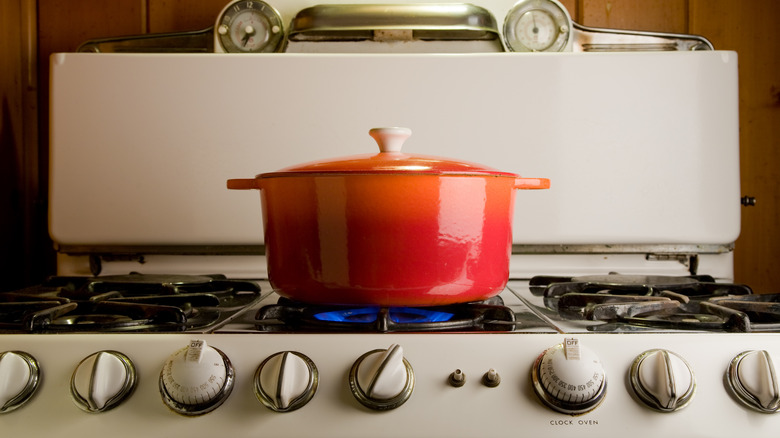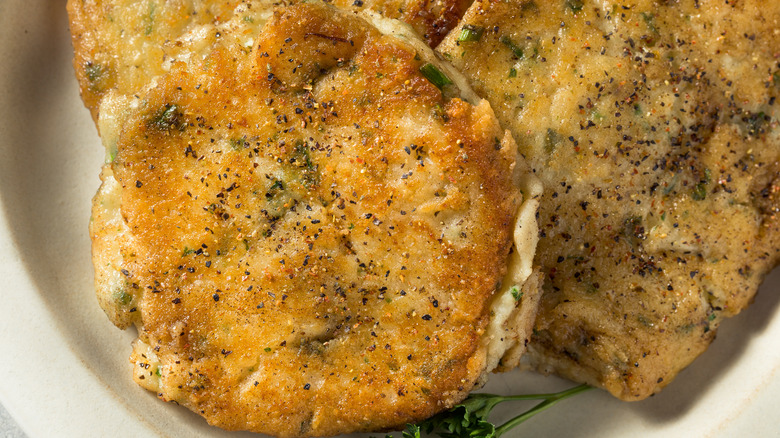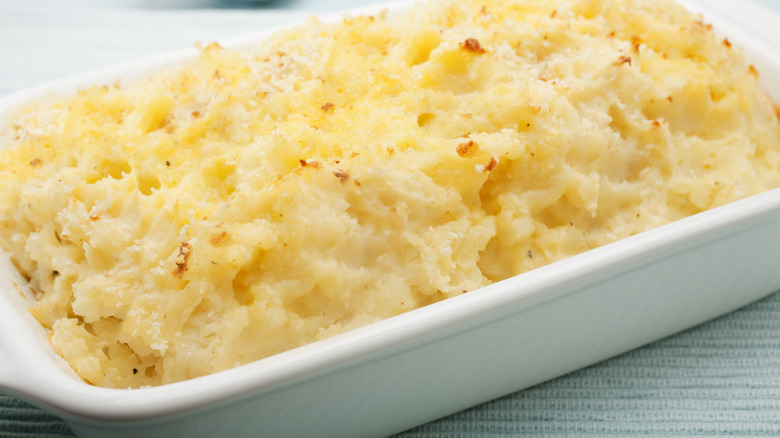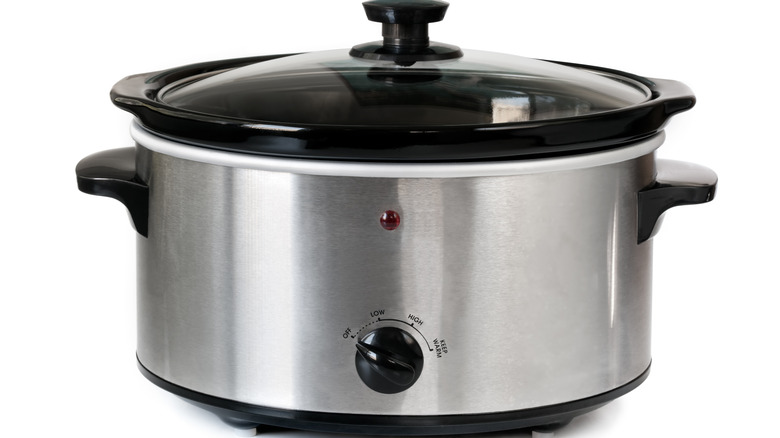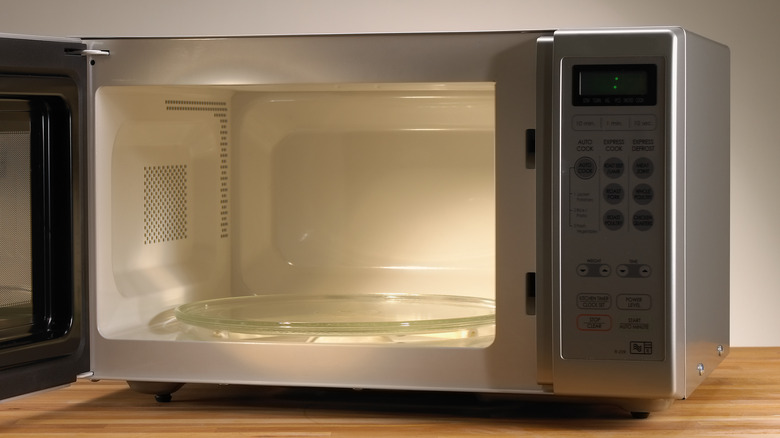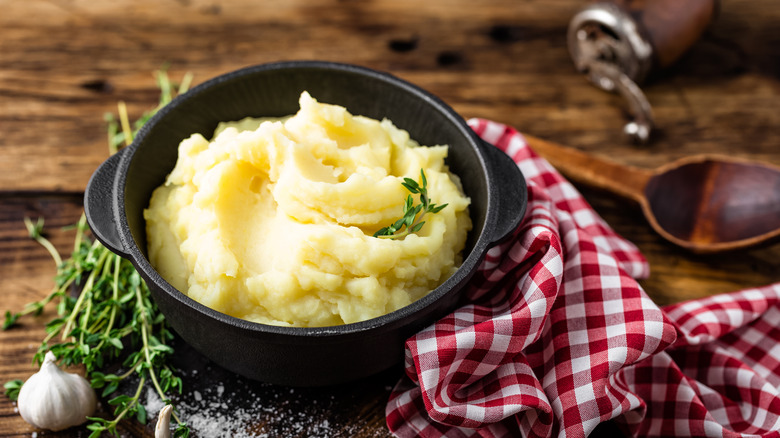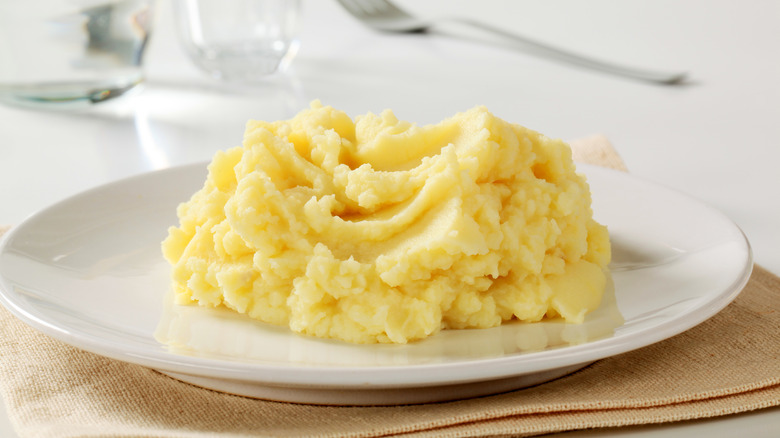14 Expert Tips For Freezing And Reheating Mashed Potatoes
Mashed potatoes may be the ultimate side dish. Creamy, pillowy, and versatile, they serve as the ideal accompaniment for a range of main meals, from simple grilled salmon to a Thanksgiving turkey. As well as being easy to make, mashed potatoes have a further advantage in being one of those dishes you can make well ahead of time, a technique employed by restaurants across the country. Kitchens will frequently prepare their mashed potatoes almost to the point of completion, with the dairy element added as the potatoes are reheated just before they're served.
This nifty trick is a lifesaver if you're planning a big meal and want to make your mashed potatoes a day or two in advance — and you can even freeze mashed potatoes months ahead of time, and they'll remain tasty. But, if you do this, what's the best way to store them, and how do you bring them back up to temperature? Improper freezing of mashed potatoes can leave them with freezer burn or make them become dry, mealy, or watery. Reheating them incorrectly can also leave you with a grainy, flavorless plate of food. That's why we decided to collect our favorite advice from culinary experts, which can be executed by even novice chefs, to offer various ways to freeze and reheat mashed potatoes using a wide range of kitchen appliances.
1. Use an ice cream scoop to portion out your mashed potatoes
One of the trickiest things about freezing mashed potatoes is doing so in a way that's portion-specific. Because mashed potatoes become one solid mass of food when prepared, trying to retrieve individual portions from a frozen block can leave you frustrated and potentially ruin your food.
But a nifty trick from Dan Souza, editor-in-chief of Cook's Illustrated, can avoid all of that. "Using a large ice cream scoop or measuring cup, place one-cup portions of mashed potatoes on a baking sheet that you've lined with parchment paper," Souza explains on YouTube. You should then place the baking sheet inside your freezer until they've completely frozen. Place the potatoes in individual freezer bags and stash them in your freezer until you're ready to eat them. This trick, Souza explains, is particularly useful if you've made too many mashed potatoes and need to save some for next time. The individual portioning means that next time you have a craving for it, you can pull out as many bags as you need and thaw them at will.
2. Avoid bacterial risk by cooling them properly
Mashed potatoes can retain heat exceptionally well due to their density. But this can create a problem when you're trying to freeze them. If you try and put them in the freezer straight away, you'll cause them to heat up, potentially melting and ruining the other food inside. Leave them out on the counter for too long, however, and you'll end up causing them to be at risk of bacteria. "It's important to maintain the potatoes at a safe temperature before freezing. Letting them sit between 41 and 135°F allows for bacterial growth. You wouldn't want to let Thanksgiving potatoes to sit on a buffet table for 2 hours [prior to] freezing," warns expert preserver Kris Bordessa in Southern Living.
Instead, Bordessa advises trying to get your mashed potatoes into the fridge as soon as possible. This will chill them to a safe temperature until you're ready to freeze them. Try not to place them in the fridge when they're too warm, however, as you'll create a load of condensation in your appliance, which could affect the other food inside. Once it's sufficiently cooled, it can then be transferred to the freezer.
3. When freezing mashed potatoes, your potato choice is important
Not all mashed potatoes will freeze in the same way due to the way they change when they're plunged into sub-zero temperatures. "The liquid absorbed by the potatoes while cooking will form ice crystals when they are frozen," states personal chef Carlos Montoya to Insider. These ice crystals can then alter the texture of the potatoes and can cause them to become overly sloppy.
You can sidestep this by being wise about your choice of potato to make your mash. Montoya strictly dictates that Yukon Gold or Russet potatoes are the best choice for mashed potatoes you're planning to freeze, as they have a higher starch content and contain less water. This will leave them with less ice formation, allowing them to retain their texture better. Idaho potatoes can also be great for this, thanks to their starchiness.
Waxy potatoes, on the other hand, are best avoided for making frozen mashed potatoes because they have higher water levels. Varieties like Dutch Cream, Kipfler, and Pink Fir Apple potatoes will leave you with a sludgier mash that can be more purée-like and disintegrate into soup upon defrosting.
4. Plenty of cream will protect your frozen mashed potatoes
Keeping mashed potatoes tender in the freezer can be trickier than you think. When exposed to the freezer's harsh temperature, the mash's flavor and texture can change significantly, with the potatoes losing their taste and often becoming surprisingly tough or even a little gritty.
So, finding ways to retain smoothness and richness is vital — and adding plenty of dairy products is the way to go, states the Pioneer Woman herself, Ree Drummond, in Pioneer Woman. If you know you're going to be freezing your mashed potatoes, you should add way more butter or cream than you normally would. Doing this keeps your mashed potatoes smooth and creamy while frozen, as the dairy fats encase the potatoes and protect them.
Mashed potato recipes made with broth, on the other hand, are best eaten straight away and not frozen. Broth adds moisture without any protective fat, and when it's frozen, it turns into ice crystals, which may ruin the texture of the potatoes. It's also important to not use a low-fat dairy product when doing this — the whole point is that you need more fat, not less.
5. Excess air is your worst enemy
When it comes to mashed potatoes, a little air can be a good thing. Getting some air into the potatoes by whipping them can make your mash lighter and fluffier, although overwhipping them can lead to a gummy, starchy mixture. But when freezing them, limiting air as much as possible is advisable. Leaving mashed potatoes exposed to cold air in your freezer can increase the possibility of freezer burn, which occurs when the food is sapped out of moisture due to air exposure.
That's why personal chef Carlos Montoya suggests trying to rid your containers of as much air as possible or else creating a physical barrier between the air and the mashed potatoes. If you're placing your mashed potatoes in Tupperware, try pushing some parchment paper or plastic wrap onto the top of the potatoes, which will stop them being in contact with the freezing air once the lid is shut.
Ideally, though, you should be using small enough containers to be able to fill them right to the top. The same goes for freezer bags: Try to use smaller ones to reduce cold air exposure and squeeze or suck extra air out of them before sealing them. You can also do this by rolling the bag up with your mashed potatoes at the bottom, pushing out the air as you do so.
6. Label your frozen mashed potatoes when you freeze them
Mashed potatoes freeze very well. So well, in fact, that when they're stored properly, in "a freezer set to 0°F or colder," they can last "up to one year," says food-freezing pro Crystal Schmidt, per Southern Living. But with this length of time also comes risk. If you're not careful, it's easy to forget when exactly you made your mashed potatoes and when you should eat them. And if you do, you may end up with years-old mash on your plate.
Thankfully, the way to solve this is simple: You just have to label your mashed potatoes when freezing them. Once your potatoes are cool, place them in your container and close it, and then rip off a piece of masking tape, sticking it on. Ensure that the box is dry and doesn't have any condensation on the outside, as this can make it harder for the tape to stick. Write down the date you made the mashed potatoes, the date you should consume them, and any further specific notes you have. If, for example, you're freezing two types of mashed potatoes, one that's lactose-free and one that has cream, you'll want to note the difference.
7. Use certain reheating methods to avoid graininess
When reheating mashed potatoes, graininess can be a particular issue. This can happen for a few reasons, from using specific types of potatoes to not using enough fat in your recipe, but it can also occur due to particular reheating methods. While using the oven and the microwave are usually the most common ways to defrost and reheat mashed potatoes, they can also, if you're not careful, ruin their texture.
However, you can avoid this easily by using an alternative technique, says "Freeze Fresh" author Crystal Schmidt. "To reduce the graininess that frozen mashed potatoes often have, thaw [the potatoes in the refrigerator] and then heat them in a saucepan," Schmidt says via Southern Living. Make sure you're using gentle heat so that they heat through slowly and evenly. Then, when they're hot, Schmidt says to "use a silicone spatula to fold the potatoes forcefully against the sides of the pan for 15 to 30 seconds." This quick action will help to reincorporate the potatoes with their liquid, smoothing them out. It will also help to smush up any clumps of potato, which may have avoided being mashed the first time around.
8. When reheating on the stove, keep your heat low
Reheating mashed potatoes doesn't take forever, but it can take longer than you think. Mashed potatoes are a particularly dense food item, so the heat can take longer to permeate. And if you're reheating them on the stove, the temptation can be to turn the heat up high to try and hasten the process along.
This, though, is a big mistake. If you turn them up too much, you will essentially start to recook the mashed potato, breaking it down even further. Even worse, the high heat may cause the mashed potato to cling to the pan and may even scorch and burn it.
Instead, you should always keep your heat low as you reheat them, says Pioneer Woman. This will avoid any nasty accidents and an unexpected wash-up operation for your pan. It's also a good idea to use a nonstick pan to further avoid sticking. As you heat them, make sure you're stirring them constantly. Remember that the heat is coming from the bottom of the pan, so the underside of the mash will become hotter way faster. Stirring will help to distribute the heat properly throughout.
9. Fry cold mashed potatoes in butter to improve their texture
The main appeal of mashed potatoes is their soft, pillowy, buttery texture, the neutrality of which pairs excellently with more texturally specific foods. But that's not to say that mashed potato can't be interesting on its own, and one of the best ways to achieve this is when you're reheating it. Fisk & Co.'s executive chef Ashlee Aubin recommends slicing up your mashed potatoes into one-inch-wide rounds or slabs. Then, use some butter to fry them up, flipping them halfway through. "It creates a little brown crust as the inside gets warm and melty," Aubin says via Eat This, Not That.
If you're taking this approach, though, it's worth keeping in mind the density of your mashed potatoes. Only fry them up if they're more on the solid side, as using a mashed potato that's too slack or a whipped mash will cause it to melt in your pan. This method also works best when the mashed potatoes are straight out of the fridge. The coldness of the mash will help the starch to set, giving you a solid block of food to work with, which helps to cut them more precisely.
10. Add cream to reheat your potatoes in the oven
While you don't necessarily need butter or cream to make excellent mashed potatoes, they definitely help. Using butter or cream fills your potatoes with dairy fats, making them creamier — and using cream, full-fat milk, or half-and-half can also provide some moisture through its water content.
But when reheating mashed potatoes, this water content can quickly dissipate as it evaporates into steam. This is particularly common in the oven, where the dry heat used can also create a dry, cracked top. You can counteract this by using some extra butter or cream before placing your potatoes in the oven, a top tip suggested by JMB Culinary Consulting owner and recipe developer JeanMarie Brownson.
Adding these will help to combat evaporation or dryness and add some extra creaminess to your potatoes. If using cream, try adding a few dashes around the edges of your potatoes before taking the dish out once they're slightly warm and stirring it in. To add butter, simply slice up some pats and scatter them over the top of the potatoes, again giving the whole thing a stir once the butter's melted and the potatoes are slightly softer.
11. Reheat straight at the table with a slow cooker
While it might not be appropriate to place your slow cooker on the dining table at every event, for more casual dinners, it can serve two functions in one. By reheating your mashed potatoes in your slow cooker, you give yourself a vessel to serve them out of and a fuss-free method of reheating them. Simply set your slow cooker to low, place your mashed potatoes inside, and allow them to reheat until hot throughout.
Once you've reheated them, you can unplug your slow cooker, so you don't have to worry about people tripping over the power cord, and your food will retain heat. "Creamy or thick side dishes such as mashed potatoes or candied sweet potatoes, and even macaroni and cheese will stay hot for an hour or more," explains America Test Kitchen's test cook Ashley Moore on YouTube. Crucially, though, keep an eye on your mashed potatoes as they're heating up. It may be the case that you need to add in some more liquid to slacken them slightly or stir them every now and again so they don't stick to the bottom of the pot.
12. Microwave frozen mashed potatoes straight from the freezer
If you need to thaw mashed potatoes quickly, the microwave is likely your best friend. Whereas leaving them in the fridge to defrost can take hours, the microwave can make your mashed potatoes edible again in mere minutes — but to thaw them, you'll want to reduce the power. "Place a portion in a microwave-safe bowl, cover, and microwave at 50% power for about five minutes, stirring occasionally until they're heated through," states Cook's Illustrated editor-in-chief Dan Souza via YouTube.
Reducing the power is important here, as it will heat the mashed potatoes more gently than if you were blasting it on full. Remember that microwaves heat food primarily from the outside in, and so by using 50% power, you allow the inside of the mashed potato to be slowly heated from the exterior, warming up and thawing it with more control. If you have a large portion, increase the time you're cooking it by slightly to ensure that everything's piping hot. Additionally, keep a small jug of cream or milk to hand, and when you're stirring your potatoes, check to see if they need some extra moisture, adding it in as necessary.
13. A double-boiler is a quick way to reheat gently
While microwaves, ovens, and stovetop pans might be effective for reheating mashed potatoes, they can all do so pretty intensely, leading to the potatoes losing their smoothness and becoming mealy. Although you can reduce the power or heat with any of these methods, a gentle, temperature-controlled option is arguably better, like a double boiler. Put your mashed potatoes in a heatproof bowl, and then place it over a pot of water on a low simmer. As double boilers keep the potatoes away from direct heat, they'll warm them up gently and consistently.
However, as you're doing this, "Be careful not to overmix the potatoes, or they'll turn gluey," warns America's Test Kitchen test cook Ashley Moore, per YouTube. As you mix your potatoes, they'll release more and more starch; if you overdo it, that starch will cause a gumminess that will make them deeply unappetizing. The key is to fold them gently, stopping when they're just warm enough to serve. Usefully, you can also leave potatoes in a double boiler for a few minutes after preparing, and they'll stay warm thanks to the residual heat from the steam.
14. Perform a taste test after you reheat
Regardless of how you reheated your mashed potatoes, you'll need to do a quick taste test after you eat. Why? Because you may have disrupted the balance of your recipe. "After reheating, check for seasonings, they may need a little more salt and pepper — especially if you've added more cream," says recipe developer JeanMarie Brownson via Martha Stewart. Extra cream or butter is essential when warming up mashed potatoes to keep them slack and creamy, but they can also make your potatoes taste too dense if they're not leveled out with your other additions.
Keep in mind, too, that the type of butter you add, or the amount, can alter things significantly. If you're adding salted butter, for example, you may find that your potatoes are actually too salty, and it's difficult to rectify this without mashing up some more and mixing them in. Adding too much butter or cream, meanwhile, can leave your potatoes soupy and overly greasy. The best rule of thumb is to be careful and take things slowly, only adding more ingredients as you need to.
